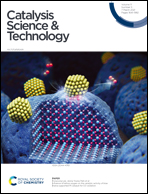Tunable selectivity of phenol hydrogenation to cyclohexane or cyclohexanol by a solvent-driven effect over a bifunctional Pd/NaY catalyst†
Abstract
Hydrogenation of phenol is an important strategy to produce cyclohexane or cyclohexanol as both of them are raw materials for the synthesis of nylon-6 and nylon-66. Herein, we report a novel method for the selective hydrogenation of phenol to cyclohexane or cyclohexanol over a bifunctional Pd/NaY catalyst by regulating the solvent polarity. It was found that solvent polarity has a strong influence on the hydrogenation reaction mechanism. Under the identical conditions, 100% selectivity to cyclohexane could be obtained when reacting in n-octane (nonpolar solvent), while 92.3% selectivity to cyclohexanol was achieved in EtOH (polar solvent). The polarity of the solvent not only affects the competitive adsorption capacity but also the adsorption manner of phenol over the acid sites and the Pd nanoparticles in the Pd/NaY catalyst. DFT calculations show that different solvents have an almost negligible effect on the reaction energy barriers but highly affect the hydration reaction of cyclohexanol if the trace amount of water formed could not be timely removed from the catalytic system. This solvent-driven catalysis exhibits good recyclability, showing great promise for industrial applications. These findings not only provide new insights into the hydrogenation mechanism of phenolics, but also might help to develop facile strategies for the selective conversion of other phenolics into desired products.



 Please wait while we load your content...
Please wait while we load your content...